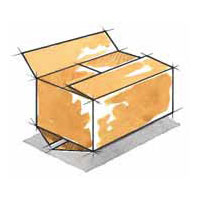Box Styles
Here at Box one we offer many styles of Boxes. We can design the box for you, or if you have your own dies, we can produce any style of box to fit your company's needs
-
Box 101
Dimensions for cartons must always be given in order as length x width x depth. Length (L) is always the longest of the two side panels. Width (W) is always the shorter of the two side panels. Depth (D), sometimes referred to as height, is the dimension from the top to the bottom flaps. It is usual and customary to give box dimensions as inside dimensions. Finished box sizes must be reduced if you are given outside dimensions. -
RSC (Regular Slotted Container)
The RSC is the most common style of shipping or packing box. All flaps have the same length. The flaps are one half the container’s width so the flaps from the length panels meet in the center of the carton on the top and bottom when it is folded. -
FOL (Full Overlapping Slotted Container)
This is the same basic construction as the RSC, but the flaps are the full width of the container. The flaps from both length panels fold to fully overlap one another on the top and bottom when folded. This provides extra protection for product when shipping, as well as extra stacking strength.- A FOL can be run as a side load or end load.
-
HSC (Half Slotted Container)
This is also a similar construction to the RSC, but there are flaps only on one opening. HSC's are commonly used as bins, displays or covers. An HSC bottom carton can be fitted with a Tray style top or a slightly larger HSC style top for stacking, shipping or protection from dust.
- HSC displays will often have flanges on the open end of the carton.
- It is common to fit HSC displays with wood strips for stability. The wood strips are sometimes used to attach a grid to the top of the carton to hold product in place.
- HSC displays may also be designed with partitions to separate and hold the product in place. Partitions may be slotted dividers, tubes, or die cut joined double tubes.
-
Tray
Often referred to as a “shoe box”, a TRAY is a slotted and scored sheet that when folded can be secured and made into an open carton. It can be fitted with another TRAY top or used as a top itself for an HSC. TRAY's are useful for shipping displays or other items with a shallow depth where corner protection may be an issue. -
OPF (One Piece Folder)
OPF (One Piece Folder) This style is extremely useful for packing items that have very small depths like DVD’s, CD’s, books and other printed materials. OPF's can also be manufactured with "aircells" on the tuck ends or FOL flaps for added protection. -
3PF (3 Panel Folder)
3PF (3 Panel Folder) A 3PF is the same as an OPF except it does not have a depth. It is essentially a single scored depth that still has tucks to protect all four edges of the product. This style is commonly used for posters or very thin signage that may require extra protection. -
DIE CUT
DIE CUT items are almost limitless as to the forms that they can produce. They can be manufactured with curved or angled edges, openings for viewing or touching product, etc. All DIE CUT items require the purchase of tooling, which can vary greatly depending on the size and style. DIE CUT cartons may be un-joined or joined. A common example of a DIE CUT carton is a pizza style box. -
Tube/Pad/Scored Sheet
TUBE A tube is simply four side panels with no top or bottom flaps. It can be joined or left un-joined depending on customers use. Tubes are often used inside a shipping carton as dividers for a product.- Tubes may have flanges on one or both ends. Flange sizes can vary depending on the application of the tube.
PAD Pads are flat pieces of corrugated board. A pad has no scores or slots, but can be printed.
SCORED SHEET A scored sheet is a pad that has scores.








